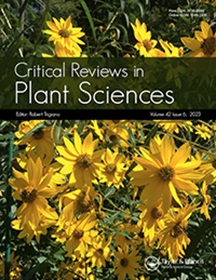Stop the Abuse of Time! Strict Temporal Banding is not the Future of Rank-Based Classifications in Fungi (Including Lichens) and Other Organisms
IF 4.9
2区 生物学
Q1 PLANT SCIENCES
引用次数: 37
Abstract
Abstract Classification is the most important approach to cataloging biological diversity. It serves as a principal means of communication between scientific disciplines, as well as between scientists on one hand and lawmakers and the public on the other. Up to the present, classification of plants, fungi, and animals follows the fundamental principles laid out more than 250 years ago by Linnaeus, with less changes in the formalistic approach although with somewhat diverging rules for plants and fungi on one hand and animals on the other. Linnean classifications obey two fundamental rules, the binomial as basic format for species names, including a genus-level name and a specific epithet, and rank-based higher classifications, with the main ranks encompassing genus, family, order, class, phylum (division), and kingdom. Given that molecular phylogenies have reshaped our understanding of natural relationships between organisms, and following the cladistic principle of monophyly which defines groups but not ranks, it has been repeatedly argued that rank assignments are artificial and subjective, with the suggestion to either abandon rank-based classifications altogether or apply more objective criteria to determine ranks. The most fundamental of such approaches has been the correlation of rank with geological (evolutionary) age, first established by Hennig in the middle of the past century and around the turn of the millenium formalized as “temporal banding,” based on the advent of the molecular clock. While initially the temporal banding approach received less attention, in the past ten years several major studies mostly in vertebrates (birds, mammals) and fungi (chiefly lichenized lineages) have proposed novel classifications based on a strict temporal banding approach, partly with highly disruptive results. In this paper, the temporal banding approach is critically revised, pointing out strengths and flaws, and “best practice” recommendations are given how to employ this technique properly and with care to improve existing classifications while avoiding unnecessary disruptions. A main conclusion is that taxa recognized at the same rank do not have to be comparable in age, diversity, or disparity, or any other single criterion, but their ranking should follow integrative principles that best reflect their individual evolutionary history. In a critical appraisal of changes to the classification of Lecanoromycetes (lichenized Fungi) proposed based on temporal banding, the following amendments are accepted: Ostropales split into Graphidales, Gyalectales, Ostropales s.str., and Thelenellales; Arctomiales, Hymeneliales, and Trapeliales subsumed under Baeomycetales; Letrouitiaceae subsumed under Brigantiaeaceae; Lobariaceae and Nephromataceae subsumed under Peltigeraceae; Miltideaceae subsumed under Agyriaceae, and Protoparmeloideae and Austromelanelixia as new subfamily and genus within Parmeliaceae. The following changes are not accepted: Rhizocarpales split into Rhizocarpales s.str. and Sporastatiales (no information gain); Sarrameanales split into Sarrameanales s.str. and Schaereriales (no information gain); Carbonicolaceae subsumed under Lecanoraceae (topological conflict); Graphidaceae split into Diploschistaceae, Fissurinaceae, Graphidaceae s.str., Thelotremataceae (no information gain, topological conflict); Ochrolechiaceae split into Ochrolechiaceae s.str., Varicellariaceae, and Variolariaceae (no information gain, nomenclaturally incorrect); Porinaceae replaced by Trichotheliaceae (nomenclaturally incorrect); Ramalinaceae split into Biatoraceae and Ramalinaceae s.str. (no information gain, topological conflict); Stereocaulaceae subsumed under Cladoniaceae (nomenclaturally incorrect); Thrombiaceae subsumed under Protothelenellaceae (topological conflict); and all proposed genus level synonymies in Parmeliaceae. New fungal taxa: The new order Odontotrematales Lücking ordo nov. is established for the family Odontotremataceae s.str., based on topological grounds.停止浪费时间!严格的时间分带不是真菌(包括地衣)和其他生物基于等级分类的未来
摘要分类是对生物多样性进行编目的最重要方法。它是科学学科之间以及科学家与立法者和公众之间沟通的主要手段。到目前为止,植物、真菌和动物的分类遵循250多项基本原则 几年前,林奈对形式主义方法的改变较少,尽管对植物和真菌以及动物的规则有所不同。林奈分类遵循两个基本规则,二项式是物种名称的基本格式,包括属级名称和特定的称谓,以及基于等级的更高分类,主要等级包括属、科、目、纲、门(科)和界。鉴于分子系统发育重塑了我们对生物体之间自然关系的理解,并且遵循单系分支原则(定义群体而非等级),人们一再认为等级分配是人为的和主观的,建议要么完全放弃基于等级的分类,要么应用更客观的标准来确定等级。这些方法中最基本的是等级与地质(进化)年龄的相关性,这是Hennig在上个世纪中期和千禧年前后首次建立的,基于分子钟的出现,被正式化为“时间带”。虽然最初时间带方法受到的关注较少,但在过去十年中,几项主要针对脊椎动物(鸟类、哺乳动物)和真菌(主要是地衣谱系)的主要研究提出了基于严格时间带方法的新分类,部分结果极具破坏性。在本文中,对时间条带方法进行了严格修订,指出了其优势和缺陷,并提出了如何正确使用这项技术的“最佳实践”建议,以改进现有的分类,同时避免不必要的干扰。一个主要结论是,在同一级别上被认可的分类群不必在年龄、多样性或差异或任何其他单一标准上具有可比性,但它们的排名应该遵循最能反映其个体进化史的综合原则。在对基于时间条带提出的地衣化真菌分类变化的批判性评估中,接受了以下修改:Ostropales分为Graphidales、Gyalectales、Ostropales.str.和Thelenellales;弓形虫目、海绵藻目和斜方虫目归入放线菌目;灯心草科,归入百香草科;龙须菜科和肾花科归入水芹科;Miltideaceae隶属于Agyriaceae,Protoparmeloideae和Austromelanelia是Parmeliaceae中新的亚科和属。以下变化不被接受:根果类分为根果类和孢子类(无信息获取);Sarrameanales分为Sarrameanales.str.和Schaereriales(无信息增益);碳螺科归入Lecanoaceae之下(拓扑冲突);Graphidaceae分为Diploscitaceae、Fissurinaceae、Graphidaeae s.str.、Thelotremataceae(无信息获取,拓扑冲突);Ochrolechiaceae可分为Ochrolethiaceae s.str.、Varicellariaceae和Variolariaceae(没有获得信息,命名不正确);茯苓科被毛霉菌科取代(命名不正确);Ramalinaceae分裂为Biatoraceae和Ramalinacae s.str.(无信息获取,拓扑冲突);立体茎科,归入枝孢科(命名不正确);Thrombiaceae包含在Protothelenellaceae之下(拓扑冲突);以及所有提出的Parmeliaceae属级同义词。新的真菌分类群:新的Odontotrematales Lücking ordo nov.目是根据拓扑基础为Odontotremateaceae s.str.科建立的。
本文章由计算机程序翻译,如有差异,请以英文原文为准。
求助全文
约1分钟内获得全文
求助全文
来源期刊
CiteScore
12.90
自引率
1.40%
发文量
15
审稿时长
>12 weeks
期刊介绍:
Critical Reviews in Plant Sciences focuses on presenting in-depth and up-to-date reviews of timely and/or cutting-edge subjects in the broad discipline of plant science, ranging from molecular biology/biochemistry through the areas of cell biology, plant pathology and physiology, genetics, classical botany, and ecology, to practical agricultural applications. Articles in the journal provide an up-to-date literature base for researchers and students, pointing the way towards future research needs. The journal is also a significant source of credible, objective information to aid decision makers at all levels.

 求助内容:
求助内容: 应助结果提醒方式:
应助结果提醒方式:


